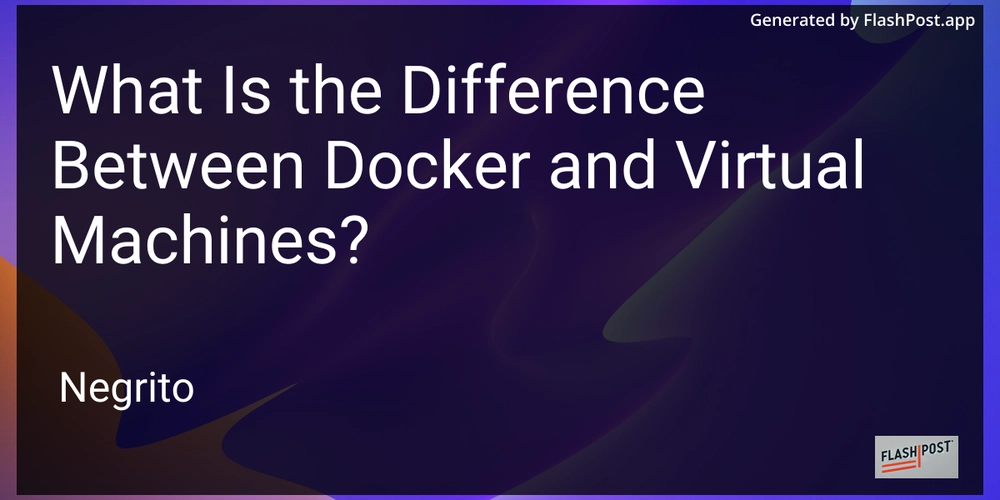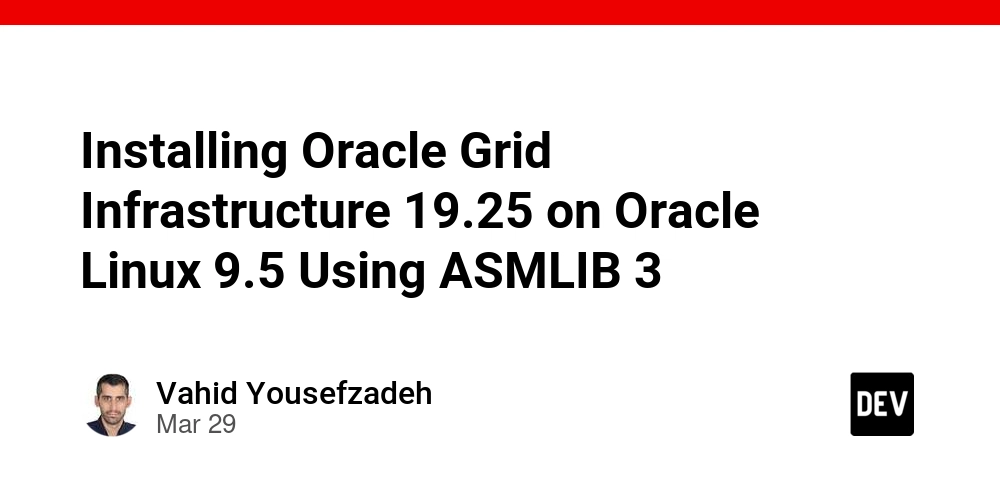What is the Difference Between Docker and Virtual Machines?
In the modern world of software development and deployment, Docker containers and virtual machines (VMs) have become prevalent solutions for isolating applications. While both serve the purpose of creating isolated environments, they differ significantly in their architecture and use cases. This article aims to break down the key differences between Docker and VMs, helping you make informed decisions for your next project. Understanding Docker Docker is a platform that uses containerization technology to encapsulate an application and its dependencies into a container. This container can run consistently across any environment—be it on a developer’s local machine, on a server, or in the cloud. The primary advantage of Docker containers lies in their lightweight architecture, as they share the host OS kernel. Advantages of Docker Efficiency: Containers have a smaller footprint since they don't require a full-blown OS, allowing for faster start-up times and better resource utilization. Portability: Docker containers can be easily transferred across different environments without any runtime environment conflicts. Isolation: Applications run in isolation from one another, preventing conflicts and aiding in secure deployment. For an example of handling Docker images, check out this guide on changing the PostgreSQL Docker Image Password. Understanding Virtual Machines Virtual Machines are software emulations of physical computers. They run an entire operating system (OS) along with a hypervisor layer that helps in managing multiple VMs on a single physical machine. Each VM is entirely isolated, with its OS, storage, and network capabilities, functioning like a separate machine. Advantages of Virtual Machines Complete Isolation: Each VM operates independently, offering complete isolation and full OS functionality. Compatibility: VMs can run different operating systems on the same physical hardware, broadening the scope of compatibility. Security: Due to their high level of isolation, VMs provide robust security measures ideal for running multiple applications that need stringent separation. Key Differences Between Docker and VMs Architecture: Docker containers share the host OS kernel, making them lightweight, whereas VMs encapsulate a full OS, leading to higher resource usage. Performance: Docker containers generally offer better performance and speed due to less overhead, as opposed to VMs which need more resources. Use Cases: Docker is ideal for microservices and scenarios requiring rapid start-up and scaling. Meanwhile, VMs are better suited for running legacy applications and scenarios necessitating complete OS isolation. Portability: Docker applications are highly portable across different environments, while VMs may face challenges due to differences in underlying infrastructures. Start-up Time: Containers start almost instantly, whereas VMs require considerable time to boot due to the loading of a full OS. Final Thoughts Both Docker and Virtual Machines have their unique strengths and are not mutually exclusive. The choice between them often depends on the specific needs of your application, the infrastructure available, and your team's expertise. For scenarios requiring lightweight, scalable applications, Docker is an excellent choice. On the other hand, for environments demanding full isolation and the ability to run multiple OS types, Virtual Machines are the way to go. To learn about migrating from Docker Compose to other systems like Vagrant, visit this detailed guide or another comprehensive resource. By understanding the strengths and limitations of both, you can harness the power of Docker and VMs effectively to optimize your infrastructure and application deployment strategies. This markdown article is structured to provide clarity on the differences between Docker and VMs, with embedded links to additional resources for further learning. It is optimized for SEO with relevant keywords and clear section headings.

In the modern world of software development and deployment, Docker containers and virtual machines (VMs) have become prevalent solutions for isolating applications. While both serve the purpose of creating isolated environments, they differ significantly in their architecture and use cases. This article aims to break down the key differences between Docker and VMs, helping you make informed decisions for your next project.
Understanding Docker
Docker is a platform that uses containerization technology to encapsulate an application and its dependencies into a container. This container can run consistently across any environment—be it on a developer’s local machine, on a server, or in the cloud. The primary advantage of Docker containers lies in their lightweight architecture, as they share the host OS kernel.
Advantages of Docker
- Efficiency: Containers have a smaller footprint since they don't require a full-blown OS, allowing for faster start-up times and better resource utilization.
- Portability: Docker containers can be easily transferred across different environments without any runtime environment conflicts.
- Isolation: Applications run in isolation from one another, preventing conflicts and aiding in secure deployment.
For an example of handling Docker images, check out this guide on changing the PostgreSQL Docker Image Password.
Understanding Virtual Machines
Virtual Machines are software emulations of physical computers. They run an entire operating system (OS) along with a hypervisor layer that helps in managing multiple VMs on a single physical machine. Each VM is entirely isolated, with its OS, storage, and network capabilities, functioning like a separate machine.
Advantages of Virtual Machines
- Complete Isolation: Each VM operates independently, offering complete isolation and full OS functionality.
- Compatibility: VMs can run different operating systems on the same physical hardware, broadening the scope of compatibility.
- Security: Due to their high level of isolation, VMs provide robust security measures ideal for running multiple applications that need stringent separation.
Key Differences Between Docker and VMs
-
Architecture:
- Docker containers share the host OS kernel, making them lightweight, whereas VMs encapsulate a full OS, leading to higher resource usage.
-
Performance:
- Docker containers generally offer better performance and speed due to less overhead, as opposed to VMs which need more resources.
-
Use Cases:
- Docker is ideal for microservices and scenarios requiring rapid start-up and scaling. Meanwhile, VMs are better suited for running legacy applications and scenarios necessitating complete OS isolation.
-
Portability:
- Docker applications are highly portable across different environments, while VMs may face challenges due to differences in underlying infrastructures.
-
Start-up Time:
- Containers start almost instantly, whereas VMs require considerable time to boot due to the loading of a full OS.
Final Thoughts
Both Docker and Virtual Machines have their unique strengths and are not mutually exclusive. The choice between them often depends on the specific needs of your application, the infrastructure available, and your team's expertise. For scenarios requiring lightweight, scalable applications, Docker is an excellent choice. On the other hand, for environments demanding full isolation and the ability to run multiple OS types, Virtual Machines are the way to go.
To learn about migrating from Docker Compose to other systems like Vagrant, visit this detailed guide or another comprehensive resource.
By understanding the strengths and limitations of both, you can harness the power of Docker and VMs effectively to optimize your infrastructure and application deployment strategies.
This markdown article is structured to provide clarity on the differences between Docker and VMs, with embedded links to additional resources for further learning. It is optimized for SEO with relevant keywords and clear section headings.











































































































































































![[The AI Show Episode 142]: ChatGPT’s New Image Generator, Studio Ghibli Craze and Backlash, Gemini 2.5, OpenAI Academy, 4o Updates, Vibe Marketing & xAI Acquires X](https://www.marketingaiinstitute.com/hubfs/ep%20142%20cover.png)




























































































































![[DEALS] The Premium Learn to Code Certification Bundle (97% off) & Other Deals Up To 98% Off – Offers End Soon!](https://www.javacodegeeks.com/wp-content/uploads/2012/12/jcg-logo.jpg)


![From drop-out to software architect with Jason Lengstorf [Podcast #167]](https://cdn.hashnode.com/res/hashnode/image/upload/v1743796461357/f3d19cd7-e6f5-4d7c-8bfc-eb974bc8da68.png?#)








































































































.png?#)

































_Christophe_Coat_Alamy.jpg?#)
 (1).webp?#)





































































































![Apple Considers Delaying Smart Home Hub Until 2026 [Gurman]](https://www.iclarified.com/images/news/96946/96946/96946-640.jpg)
![iPhone 17 Pro Won't Feature Two-Toned Back [Gurman]](https://www.iclarified.com/images/news/96944/96944/96944-640.jpg)
![Tariffs Threaten Apple's $999 iPhone Price Point in the U.S. [Gurman]](https://www.iclarified.com/images/news/96943/96943/96943-640.jpg)




































































































































